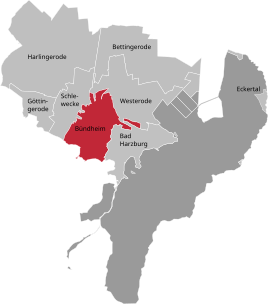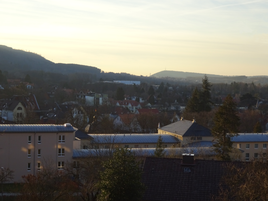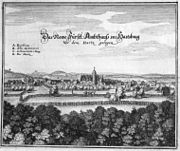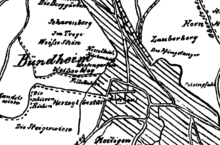Bündheim
|
Bündheim
City of Bad Harzburg
|
|
|---|---|
| Coordinates: 51 ° 53 ′ 31 ″ N , 10 ° 32 ′ 47 ″ E | |
| Height : | 226 (219–275) m above sea level NHN |
| Area : | 4.28 km² |
| Residents : | 5267 (Dec. 31, 2019) |
| Population density : | 1,232 inhabitants / km² |
| Incorporation : | July 1, 1972 |
| Postal code : | 38667 |
| Area code : | 05322 |
|
Bündheim in Bad Harzburg
|
|
Bündheim [ ˈbynt.haɪ̯m ] (in older spelling until the 19th century: Büntheim , Oker dialect : Binten ) is a district of Bad Harzburg in the Goslar district ( Lower Saxony ) with 5,267 inhabitants (as of December 31, 2019). It is located about 1.5 km northwest of the core area of Bad Harzburg and is seamlessly connected to it.
The village is known nationwide for its thoroughbred stud and its annual horse races in the sports park . The Bündheim castle once served as the seat of the Office Harzburg .
geography
Bündheim is located on the immediate northern edge of the Harz Mountains at an average altitude of 226 m above sea level. NHN . In the course of the 19th and 20th centuries, the place merged seamlessly with the neighboring towns of Bad Harzburg and Schlewecke , so that a clear separation is only given by the streets that form a noticeable break towards Bad Harzburg city center, but not at all towards Schlewecke can be seen. The place is traversed by the Bleiche , a tributary of the Radau further east . Other small tributaries such as the Füllenkuhlenbach complete the hydrological picture.
Towards Schlewecke, the Scharenberg delimits the village as part of the north edge of the Harz, and to the east, the Zauberberg as a western slope of the Butterberg .
Various subspecies of ammonites in the Bündheim area from the lower Jura have been geologically proven .
Neighboring places
|
Harlingerode Schlewecke |
Gut Radau Radauanger Mathildenhütte |
Bettingerode Westerode spring settlement |
|
Oker Göttingerode |

|
Bad Harzburg |
| Bad Harzburg |
history
Naming
The name Bündheim comes from the Old High German word biunda , which means a detached private property as opposed to communal property. Bündheim thus seems to have been removed from the older Schlewecke district in Carolingian times . In the New High German language , Bündheim can be translated into "Gutsdorf".
The following names have come down to us for Bündheim, among others:
- (1187: Behem ) *
- 1251: Colorful
- 1353: Büntem
- 1459: stage theme
- 19th century: Büntheim
- approx. 20th century: Bündheim
*controversial
Local history
Bündheim was first mentioned in a document in 1251. In 1573, Duke Julius zu Braunschweig-Wolfenbüttel's administration was relocated from Harzburg to Bündheim and an office building was built.
In the same year, Duke Julius set up the Bündheimer brass works on the basis of an older smelting works and used the furnace quarry (Hüttengalmei) , which was first made usable by the ducal council Erasmus Ebner, as an additive to the processed Mansfeld copper.
The original office building fell victim to Tilly's soldiers in the Thirty Years' War in 1626 . The office building that was then rebuilt turned out to be a bad construction. It was therefore torn down in 1685 and replaced by what is now Bündheim Palace . The knight's hall of the castle is used today for cultural events and representative receptions.
Immediately on the west side of the castle is the former regal thoroughbred stud Harzburg , whose beginnings go back to the 15th century. For the most famous horses of the stud, among them the famous Luciano , memorial stones were set up in the adjacent castle park.
The Friederike mine , which opened in the 1860s, was closed in 1963.
The culturally and geographically closely interwoven communities of Bündheim and Schlewecke merged on January 1, 1963. Finally, on July 1, 1972, Bündheim-Schlewecke was incorporated into the city of Bad Harzburg. The place came in 1974 from the Wolfenbüttel district to the Goslar district.
Between January 1, 1963 and July 1, 1972, the place was known as Schlewecke . This was due to a compromise, as the Lower Saxony ministry did not allow double names and the Schlewecker local council protested against the impending loss of name.
In 1983, Bundesstraße 6 was stepped down to the L 501 in the course of the four-lane route built further north.
The furniture store Krebs, which had already been abandoned and in a desolate state, was destroyed in 2015 by a major fire.
Bündheim Castle (south side)
Population development
While in 1798 only 625 residents were settled in a census by the Harzburg Office in Bündheim, the number of residents rose until the middle of the 20th century and has been falling since then until 2014. Since this year, the population has increased by 95 from 5,167 inhabitants (2014) to 5,262 (2017).
| Bündheim - population development since 1798 | ||||||
|---|---|---|---|---|---|---|
| development | year | Residents | year | Residents | year | Residents |
 |
1798 | 625 | 1997 | 8040 | 2017 | 5262 |
| 1849 | 1116 | 2011 | 5213 | 2018 | 5225 | |
| 1871 | 1489 | 2012 | 5235 | 2019 | 5267 | |
| 1925 | 3048 | 2013 | 5182 | |||
| 1933 | 3378 | 2014 | 5167 | |||
| 1939 | 3519 | 2015 | 5195 | |||
| 1963 | 7328 * | 2016 | 5251 | |||
|
Source: 1798, 1849 and 1871, 1925–1939, 1963, 1997, from 2011, 2018 and 2019. |
||||||
Economy and Infrastructure
As a former lumberjack and miners' village, Bündheim is now suburban. In the last few decades, the village has turned strongly to tourism, so there is a municipal indoor and outdoor swimming pool in the district with the Silberbornbad . The centuries-old tradition of horse breeding is culturally valuable, with annual horse races in the sports park and the Bündheimer Thoroughbred Stud.
In addition, the village is also partly industrially developed: The Mann + Hummel company settled on the site of the former Friederike mine , and there are also several master car workshops in Bündheim.
traffic
The L 501 ( Dr.-Heinrich-Jasper- Strasse) crosses through Bündheim, which leads from the federal highway 498 in Goslar - Oker and Göttingerode to Harzburg city center. From here there is a connection to the four-lane federal highway 4 , which leads to the federal highway 369 and over to the federal highway 36 to Braunschweig . The K 70 (Breite Straße) starts immediately in front of the Bündheimer Schloss and leads north towards Schlewecke / Harlingerode and Westerode .
The bus route 873 ( KVG Braunschweig , Ringverkehr Bad Harzburg) opens up Bündheim in the ring traffic together with Schlewecke. In addition, the 871 bus runs from Harlingerode through Bündheim to the city center and the 810 bus to Göttingerode, Oker and Goslar.
freetime and sports
A horse racing track has been located on Bündheimer Boden since 1909 , on which the Bad Harzburg horse racing week and other events not only about horses take place every July .
In the middle of the racetrack is the sports park, which was inaugurated in summer 2005, with the new clubhouse. This is where TSG Bad Harzburg plays its home football matches. This club was formed in 1993 from the two clubs TSG Bündheim / Schlewecke and BSV Bad Harzburg.
The Silberbornbad is located on the northwest side of the racetrack . Actually a year-round pool, it is only open in the summer months for cost reasons. There is an 18-hole golf course to the south and partly inside the racetrack.
The Bad Harzburg Mountain Marathon has been taking place at the racecourse since 2007 and requires runners from regional to international runners to cope with a difference in altitude of more than 300 m.
education
The Bündheim elementary school is located on Dr.-Heinrich-Jasper-Straße . As a former joint project with the Schlewecke community, today's school was also built on the Deilich .
The Bündheim kindergarten is still located in the village. Since May 2019 he has had his own vegetable patch, which is tended by children and educators as part of the "Vegetable patches for kids" project.
religion
The historic Protestant St. Andreas Church is located in Bündheim and belongs to the provost of Bad Harzburg. The Catholic St. Gregory VII Church was built in 1880 and is now part of the Liebfrauen parish in Bad Harzburg. From 1934, Christoph Hackethal was the pastor of St. Gregory's Church . When Polish and French forced laborers came to Bündheim during the war , he disregarded their mandatory segregation and made negative comments about the war and the regime in private and in church services. In 1941 he was arrested by the Gestapo and died the following year in Dachau as a result of the abuse in the concentration camp.
Personalities
- Carl Haber (* 1842 in Halberstadt ; † 1895), co-founder of the consumer association, the credit union and the large purchasing company Deutscher Consumvereine mbH (GEG) Hamburg
- Klaus Homann (1937–2004), politician ( SPD ) and former mayor of Bad Harzburg
Web links
Individual evidence
- ↑ Inkscape value: (95551.69 px² + 2545.66 px² / 1501177.21 px²) * 65.42 km².
- ↑ a b Source: City of Bad Harzburg, in: Goslarsche Zeitung : Immigrants save the population statistics , January 15, 2020.
- ↑ Dr. D Brauns: The lower Jura in northwestern Germany from the border of the Triassic to the Amaltheenthonen with special consideration of its mollusc fauna . Friedrich Vieweg and son, Braunschweig 1871, p. 493 ( online version in Google Book Search).
- ↑ Richard Wieries: Names of mountains, cliffs, valleys, springs, streams, ponds, villages, floor parts, forestry places and ways in District Court District Harzburg . In: Landesverein für Heimatschutz in the Duchy of Braunschweig (ed.): The field names of the Duchy of Braunschweig . tape 1 . E. Appelhans & Comp. GmbH, Braunschweig 1910, p. 13 f . ( PDF file on the TU Braunschweig publication server ).
- ^ Federal Statistical Office (ed.): Historical municipality directory for the Federal Republic of Germany. Name, border and key number changes in municipalities, counties and administrative districts from May 27, 1970 to December 31, 1982 . W. Kohlhammer GmbH, Stuttgart / Mainz 1983, ISBN 3-17-003263-1 , p. 272 .
- ↑ Fire ruin Möbel-Krebs - only rubble and ashes . December 23, 2015, accessed June 10, 2019.
- ↑ Wolfgang Heinemann : The Chronicle of the Harzburg Office . Hanau 2003, ISBN 3-00-011170-0 , p. 378 .
- ^ Harald Meier, Kurt Neumann: Bad Harzburg. Chronicle of a city. P. 570.
- ^ Michael Rademacher: German administrative history from the unification of the empire in 1871 to the reunification in 1990. wolfenbuettel.html. (Online material for the dissertation, Osnabrück 2006).
- ^ Harald Meier, Kurt Neumann: Bad Harzburg. Chronicle of a city. P. 641.
- ^ Harald Meier, Kurt Neumann: Bad Harzburg. Chronicle of a city. P. 717.
- ↑ The district of Goslar at a glance. Numbers, data, facts. District of Goslar, December 3, 2018, accessed on December 20, 2019 .
- ↑ Goslarsche Zeitung : A bed for young vegetables . May 7, 2019, accessed May 8, 2019.















